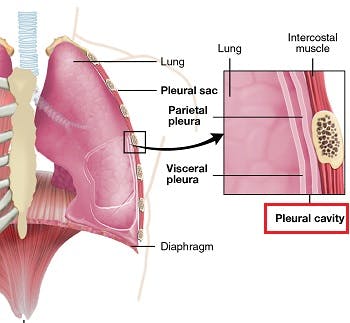Thoracentesis
Thoracentesis is a process to remove excess fluid from the pleural space to help you breathe easier. Pleural space is the small area between your lungs and chest wall. Normally, this space is filled with approximately 4 teaspoons of fluid, but some conditions such as pneumonia, lung diseases can cause more fluid to enter the space. This condition is called Pleural effusion. Extra fluid can put excess pressure on your lungs and causes difficulty in breathing. Therefore, thoracentesis is performed to help determine the cause of pleural effusion and to remove extra fluid in order to ease any shortness of breath or pain in the lungs.

Preparation
Discuss with your doctor if you have any questions regarding the procedure. Let your doctor know, if there’s a possibility that you are pregnant, allergies to any medication or any bleeding problems. You might not be able to drive after the treatment so arrange a ride to take you home.
Procedure of thoracentesis
This procedure is often performed on an outpatient basis, which means you will be able to go home the same day. You will be asked to sit on the edge of the bed or table with your arms and head resting on the table. An ultrasound may be done to determine the best location to insert the needle; this area where the needle is to be inserted will be sterilized and injected with a numbing agent. Next, the doctor will insert the needle through the skin between the ribs in your back and the fluid will be withdrawn. You might feel little discomfort during this process. At the end, the needle will be removed and a small bandage will be applied. A follow-up x-ray may be performed to detect any complication. The procedure takes around 15 minutes, unless you have a lot of fluid in your pleural space.
After procedure
After the procedure is over, your blood pressure and breathing will be monitored and an x-ray will be performed. The fluid that was withdrawn from your chest will be sent to laboratory for further investigation. Also, you’ll be able to return to daily activities soon after the procedure.
Risks of thoracentesis
Possible risks associated with thoracentesis include: * Pneumothorax or collapsed lungs * Pulmonary edema( accumulation of fluid within the lung) * Infection * Puncture of the spleen or liver * Breathing difficulty
DISCLAIMER
This web page provides general information and discussions about health, medicine and related subjects. The information and other content provided on this website, or in any linked materials, are not intended and should not be construed as medical advice, nor is the information a substitute for professional medical expertise or treatment.
The content is for information purpose only and is not a medical advice. Qualified doctors have gathered information from reputable sources; however Credence Medicure Corporation is not responsible for errors or omissions in reporting or explanations. No individual should use the information, resources and tools contained herein to self diagnose or self treat any medical condition.
If you or any other person has a medical concern, you should consult with your health care provider or seek other professional medical treatment. Never disregard professional medical advice or delay in seeking it because of something that have read on this blog or in any linked materials. If you think you may have a medical emergency, call your doctor or emergency services immediately.
The opinions and views expressed on this blog and website have no relation to those of any academic, hospital, health practice or other institution. Credence Medicure Corporation gives no assurance or warranty regarding the accuracy, timeliness or applicability of the content.
